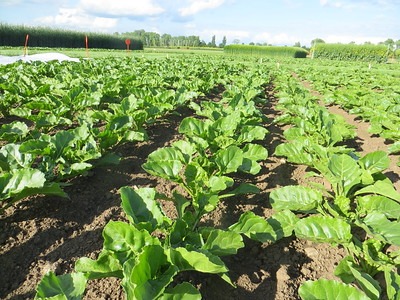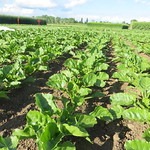
GM/Biotech Crops Report – March 2024
4th March 2024- GM/Biotech Crops Monthly Reports (BELOW) form part of BCPC’s free three-tier Biotech Crops Info service.
- This service also includes a weekly round-up of news from around the globe – see BCPC Newslink GM Crops section.
- Plus – Free access database on over 300 GM/biotech products covering 23 crops in the global market visit BCPC’s GM/Biotech Crops Manual – Register here for free access.
- Already registered? Click here
GM/Biotech Crops Monthly Report March 2024
Virus yellows in sugar beet

Virus yellows is caused by three viruses transmitted between plants by aphids and wit the recent ban on neonicotinoid seed dressings, these viruses threaten the UK beet crop again. John Innes Research Centre in conjunction with British Sugar and BBRO (British Beet Research Organisation) is developing a way of stimulating the beet immune response by designing an artificial small interfering RNA molecule that binds with the viruses and marks them for destruction by the immune system – a system akin to the first COVID-19 vaccines. Pic: KWS Group
Beefier rice dishes
A team in South Korea have developed a method of persuading beef muscle protein to grow on rice grains, thereby increasing the protein and fat content of the food. They claim that it offers a solution to famine, can be used as military rations and has a lower carbon footprint than beef because no animals are grown to produce it. Will it be coming to a Chinese restaurant near you?
Modified crops are safe
APHIS (Animal and Plant Health Inspection Service in America) has concluded its evaluation of four modified crops that are herbicide resistant (one cotton, two soybeans and one maize) and has decided that they pose no greater plant pest risk than un-modified plants and can safely be grown without regulation.
Full Story.
Europe reaches similar conclusions
EFSA (European Food safety Authority) has concluded that DP23211 and DP915635 (both maize with Coleopteran insect resistance and tolerance of glufosinate) pose no nutritional threats to humans or animals and are safe for food and feed use but the decision does not allow cultivation so they can be imported into the EU but not grown there.
Improved soy milk
The aroma of milk derived from soybeans has been improved by using CRISPR-Cas9 editing to enhance the level of 2-acetyl pyrroline in the product with no adverse effects on plant height, flowering time or total seed yield.
Salt-tolerant rice
Researchers at the Chinese Academy of Agricultural Science have used CRISPR-Cas9 editing on the OsDKA-2 gene in rice to produce a rice that is more tolerant of salt in the growing medium but also slightly shorter so presumably this will reduce the lodging risk.
Improved alfalfa forage
Researchers at Oklahoma State University have targeted the MsC3H gene in alfalfa with CRISPR-Cas9 editing to reduce the lignin content of the alfalfa shoots and thus improve the digestibility of the alfalfa when used as animal fodder.
Bread wheat improvement
Researchers at various institutions in China have discovered that knocking out the TabHLH489 transcription factor in bread wheat increases grain length and grain weight while over-expression has the opposite effect but who wants small grains?
Gene-edited maize
VIB based in Belgium has used CRISPR-Cas9 editing to modify the lignin content of maize with a view to improving the suitability for energy and paper production by increasing it and also improving the digestibility of it when used as animal fodder by reducing it. They have applied for permission to begin field trials now that the EU has a more relaxed attitude to gene-editing.
Cultured meat
Work reported in the journal of the American Chemical Society claims that the protein glutenin, derived from non-allergenic wheat varieties, makes a very good substrate on which to grow cultured meat cells to produce meat that has never been near an animal. As the world population rises they believe that there will be an increased need for this type of meat because growing animals in space, resource and water intensive. Of course it might also be more suitable for feeding colonies on the moon as we as we prepare to colonise earths’ satellite.
Wheat and Barley yield enhancement
Adelaide University in Australia is seeking comments on its proposal to conduct field tests on genetically-modified wheat and barley varieties. No details of the modifications are given but none of the grain from the 2 ha site will be used for human or animal feed.
Enhanced root growth in potatoes
Scientists from Yunnan Agricultural University in China know of a gene that controls root growth in rice and are now investigating a similar gen (StDRO2) in potatoes. Editing this gene with CRISPR-Cas9 has produced a potato that has improved auxin delivery to the roots and thus has deeper roots with improved drought tolerance. However, if the tubers are produced deeper in the soil then it might take more energy to harvest them.
Home-grown purple tomatoes
Gene-edited purple tomatoes that have enhanced anti-oxidant levels in both the skin and the flesh are to be made available to home gardeners in the United States where they have completed the regulatory process. They were developed by Norfolk Healthy Foods at the John Innes Centre in Norwich but are not available here yet.
Progress in Europe
The European Parliament has voted to open negotiations with member states about allowing gene-edited crops to be grown commercially in the EU. Thus it will be up to individual member states whether they adopt this new technology but outright genetically-modified organisms are still banned. Only gene-edited changes achieved by techniques such as CRISPR-Cas9 will currently be allowed.
Improving cotton yields
Researchers at the Henan Institute of Science and Technology have identified a crucial enzyme in the photosynthesis process of cotton. It affects the Rubisco carbon fixation point of photosynthesis and and the modification achieved improves cotton yields particularly in upland areas.
GM Bananas in Australia
Most banana plants world-wide are of the Cavendish variety developed here in the UK. This makes the whole crop very susceptible to Panama disease which could wipe them out but now Australia has given approval for commercial planting of a modified version of the Cavendish variety (called QCAV-4) that has a gene from a wild banana that confers resistance to Panama disease. Provided that the taste and shelf-life are acceptable it is sure to spread to other parts of the world. It is already planned to be grown in New Zealand.
Bioluminescent petunias
Rather than install solar-powered lights to border a path, home-owners in America can now opt to border their paths with bioluminescent petunias which will light the way to their doors. Whilst it is a bit of fun, the technique may also be bred in to crop plants to notify the grower of pest or virus attack so farmers will need to check on their crops at night as well as during the day.
Gene screening
Scientists in Australia have developed a new gene-screening platform to try to identify links between resistance and virulence genes in an effort to produce more disease-resistant varieties. No success examples have yet been announced but the method has been validated by identifying genes that combat wheat stem rust.
THE LATEST ADDITIONS TO THE GM/BIOTECH DATABASE ARE:
- DP23211 (maize with resistance to Coleopteran insects and tolerance of glufosinate) approved for food and feed use in Australia and New Zealand and for food use in Canada.
FOR INSTANT ACCESS TO GM BIOTECH MANUAL CLICK HERE (Registration required)
Already Registered? Click here to access

